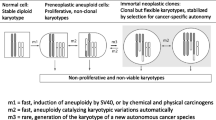Abstract
INFECTION of cells with murine leukaemia virus (MuLV) strains involves an initial interaction between the major viral glycoprotein (gp71) and specific cell surface receptors1. Virus adsorption and penetration occur only in cells having specific receptors2. Other cellular factors such as virogene integration sites may also be required for productive infections. There are three major classes of MuLV: ecotropic viruses which replicate preferentially in murine cells; xenotropic viruses which do not replicate in mouse cells but can replicate in cells from other species; and amphotropic viruses which replicate in mouse cells as well as in ells from other species. None of the three classes of virus infect hamster cells3,4. Previous studies with hamster × mouse somatic cell hybrid clones segregating mouse chromosomes showed that replication of ecotropic and amphotropic viruses required a cell function(s) coded by genes assigned to mouse chromosomes 5 and 8, respectively3. However, the function(s) of these genes was not determined. The third class of MuLV, the xenotropic viruses, could not be tested in this system since both parent cells were resistant5. In the present study, the replication patterns of ecotropic and amphotropic strains were correlated with the ability of hamster x mouse hybrid clones to bind gp71 of Rauscher leukaemia virus (RLV), an ecotropic strain of MuLV. By comparing the mouse chromosome segregation patterns of hybrid clones which retained the gp71 binding ability with those clones which had lost it, we have been able to assign the gene(s) coding for RLV cell surface receptor to mouse chromosome 5.
Similar content being viewed by others
References
DeLarco, J. & Todaro, G. J. Cell 8, 365–371 (1976).
Gazdar, A. F., Russell, E. K. & Minna, J. D. Proc. natn. Acad. Sci. U.S.A. 71, 2642–2645 (1974).
Gazdar, A. F. et al. Cell 11, 949–956 (1977).
Oie, H. K., Russell, E. K., Dotson, J. H., Rhoads, J. M. & Gazdar, A. F. J. natn. Cancer Inst. 56, 423–426 (1975).
Levy, J. A. Nature 253, 140–142 (1975).
Gillin, F. D., Roufa, D. J., Beaudet, A. L. & Caskey, C. T. Genetics 72, 239–252 (1972).
Minna, J. D., Marshall, T. H. & Shaffer-Berman, P. V. Somat. Cell Genet. 1, 355–369 (1975).
Hartley, J. W. & Rowe, W. P. J. Virol. 19, 19–25 (1976).
Rowe, W. P. & Sato, H. Science 180, 640–641 (1973).
Hilwig, I. & Gropp, A. Expl Cell Res. 75, 122–126 (1972).
Francke, U., Busby, N., Shaw, D., Hansen, S. & Brown, M. Somat. Cell Genet. 2, 27–40 (1976).
Francke, U., Lalley, P. A., Moss, W., Ivy, J. & Minna, J. D. Cytogenet. Cell Genet. (in the press).
Shows, T. B., Ruddle, R. H. & Roderick, T. H. Biochem. Genet. 3, 25–35 (1969).
Lalley, P. A., Francke, U. & Minna, J. D. 4th International Workshop on Human Gene Mapping (in the press).
Author information
Authors and Affiliations
Rights and permissions
About this article
Cite this article
OIE, H., GAZDAR, A., LALLEY, P. et al. Mouse chromosome 5 codes for ecotropic murine leukaemia virus cell-surface receptor. Nature 274, 60–62 (1978). https://doi.org/10.1038/274060a0
Received:
Accepted:
Published:
Issue Date:
DOI: https://doi.org/10.1038/274060a0
- Springer Nature Limited
This article is cited by
-
Destruction of human retinoblastoma after treatment by the E variant of encephalomyocarditis virus
Journal of Neuro-Oncology (2006)
-
Isolation and characterization of irradiation fusion hybrids from mouse Chromosome 1 for mapping Rmc-1, a gene encoding a cellular receptor for MCF class murine retroviruses
Somatic Cell and Molecular Genetics (1991)
-
Mouse map of paralogous genes
Mammalian Genome (1991)
-
Leukaemia virus receptor
Nature (1989)
-
Requirement of the human chromosome 11 long arm for replication of herpes simplex virus type 1 in nonpermissive Chinese hamster x human diploid fibroblast hybrids
Somatic Cell Genetics (1982)





